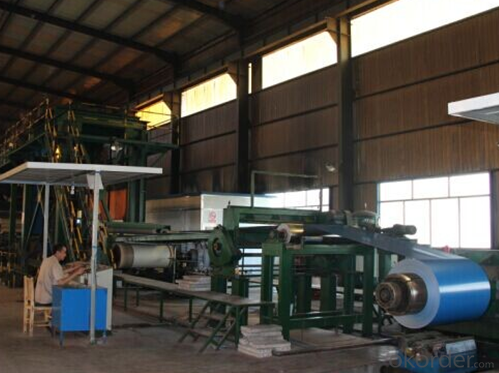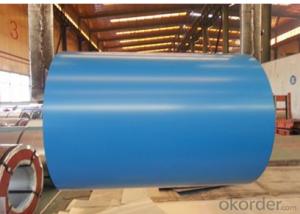EN10169 PREPAINTED GALVANIZED STEEL COIL
- Loading Port:
- Guangzhou
- Payment Terms:
- TT OR LC
- Min Order Qty:
- 25 m.t.
- Supply Capability:
- 10000 m.t./month
OKorder Service Pledge
OKorder Financial Service
You Might Also Like
Item specifice

Product Brief Introduction
EN10169 Prepainted galvanized steel coil ,with Gi as base metal after pretreatment ( degrease and chemical treatment) and liquid dope with several layers of color then after firing and cooling finally the plate steel is called Pre-painted galvanized steel is good capable of decoration ,molding corrosion resistance
Product Features
Excellent process capability
Smooth and flat surface
Workability durability
Excellent heat resistance performance
High Strength
Good formability
Good visual effect
Product Specification
Standard:ASTM, GB,JIS,JIS G3302 ASTM 755 EN10169
Grade: DX51D CGCC CS
Thickness: 0.13mm~3.0mm,
Width: 1250,600-1250mm
Coil weight:3-12 MT
Coil ID:508/610mm
Chemical composition:
C | Si | Mn | Cr | Ni | P | S |
0.150 | 0.476 | 11.231 | 12.50 | 0.900 | 0.039 | 0.010
|
FAQ
1. How long will we receive the goods ?
45days after receiving workable L/C
2. how do you control the quality ?
we have our own quality control department ,we will arrange QC person to see the production line ,when goods finish ,before shipment ,our QC person will check the quality as per our test report request ,if the goods is ok ,then we issue the test report ,and we allow the goods shipping ,otherwise will not allow ship the goods.
- Q:in a lab at school we did heat treatment of steelwhat are the possible phases present in the steel sample in as-received, as-quenched and as-tempered conditions? specifically when is it ferrite, austenite and pearliteis the steel originally in the ferrite phase? then when headed turns into austenite and when quenched martensite is formed and when tempered cermentite is formed...........where is pearlite involved and am i correct about the ferrite?
- hey from what i learned in uni last sem, steel is originally ferrite form at first at room conditions. it will undergo poly morphic transformation to become FCC structure austenite form at 912 degree celcius. under conditions, it can become pearlite (which is a combination of ferrite and cementite) or bainitie( a finer form of pearlite). queching conditions to room temperature will form martensite which is the strongest but brittle steel form. tempered cementite is formed when we quench it and then raise temperatures before sir cooling. hope it helps, pls vote me best answer is i deserve it. thanks
- Q:What are some characteristics of steel.
- Characteristics Of Steel Hardening. - The characteristic difference between steel and pure wrought iron is as follows: - When steel is raised to a red heat and then suddenly cooled, it becomes hard and brittle. This process, which is known as hardening, has no effect upon pure wrought iron. Tempering is a characteristic of steel which distinguishes it from cast iron. If steel has been hardened by being heated and suddenly cooled, as above described, it may be softened again by applying a lower degree of heat and again cooling. This is known as tempering. Cast iron, on the contrary, though it is hardened by the first process, cannot be softened by the second. When a bar of steel is struck it gives out a sharp metallic ring, quite different from the sound produced by striking wrought iron. Other characteristics of steel are its great elasticity and its retention of magnetism.
- Q:What is the minimum temperature that steel coils can withstand?
- The minimum temperature that steel coils can typically withstand without undergoing significant changes in their physical properties is around -40 degrees Celsius (-40 degrees Fahrenheit). However, this can vary depending on the specific type and grade of steel used in the coils.
- Q:What are steel coils?
- Steel coils are long, flat sheets of steel that have been wound into a coil shape. They are used in various industries for manufacturing purposes, such as in the automotive, construction, and appliance industries. Steel coils are typically made from carbon steel and are commonly used for applications that require strength and durability.
- Q:How are steel coils used in the production of industrial tanks?
- Steel coils are used in the production of industrial tanks as they are rolled into cylindrical shapes and welded together to form the tank's body. The coils provide a durable and strong structure, capable of withstanding high pressure and temperature conditions. Additionally, the steel coils can be customized to meet specific size and shape requirements, allowing for efficient and cost-effective tank production.
- Q:What are the uses of galvanized steel coils?
- Due to their unique properties, galvanized steel coils find extensive usage in diverse industries. The following are some prevalent applications of galvanized steel coils: 1. Construction: Galvanized steel coils are extensively employed in the construction sector for various purposes. They are utilized in the production of roofing sheets, wall panels, and structural components. The galvanized coating safeguards the steel from corrosion, thus increasing its lifespan and ensuring durability even in harsh weather conditions. 2. Automotive industry: The automotive industry relies on galvanized steel coils for the production of different parts and components. These coils are instrumental in manufacturing body panels, chassis, and other structural elements of vehicles. The galvanized coating provides exceptional resistance against corrosion, a vital factor for automobile longevity. 3. Appliances: Galvanized steel coils are employed in the manufacturing process of diverse household appliances, including refrigerators, washing machines, and air conditioners. These coils are used to fabricate the outer panels and cabinets of these appliances, offering them a robust and durable structure. 4. Agriculture: Galvanized steel coils also find applications in the agricultural sector. They are utilized in the production of agricultural equipment, such as grain storage silos, irrigation systems, and livestock enclosures. The galvanized coating protects the steel from rust and corrosion, ensuring the safety and longevity of these agricultural structures. 5. Industrial applications: Galvanized steel coils are widely employed in multiple industrial applications. They are utilized in the manufacturing of ductwork, ventilation systems, and industrial piping. The galvanized coating aids in resisting chemicals, moisture, and other environmental factors, making it an ideal choice for industrial environments. 6. Electrical industry: The electrical industry relies on galvanized steel coils for the production of electrical enclosures, conduit pipes, and cable trays. The galvanized coating offers excellent protection against corrosion, ensuring the safety and durability of electrical installations. 7. Furniture manufacturing: Galvanized steel coils are utilized in the furniture manufacturing industry for the production of furniture frames, shelves, and cabinets. The galvanized coating enhances the strength and durability of these furniture pieces, making them long-lasting and resistant to corrosion. In conclusion, galvanized steel coils are extensively used in various industries due to their exceptional resistance to corrosion, durability, and strength. They represent a cost-effective and dependable choice for applications that require protection against rust and environmental factors.
- Q:How can defects in steel coils be detected?
- Defects in steel coils can be detected through various methods such as visual inspection, non-destructive testing techniques like ultrasonic testing, magnetic particle inspection, eddy current testing, and radiographic testing. These methods help identify surface defects, internal discontinuities, cracks, or other irregularities in the steel coils.
- Q:I have a need to connect various stainless steel tubes and fitting together and was wondering how to do it. I know a TIG welder is an option but have heard rumors that there is a way to solder it in much the same way you affix copper pipe. Perhaps with higher heat and different flux. I need step by step and maybe suppliers of the materials. Thanks in advance and please I do not need the call a plumber answers as I've gotten in the past
- Compression Ferrel connections are the best. for small diameter pipe and tubing. A local hardware shop can supply you with the necessary parts and pieces and can also give you a step by step procedure/self help brochure. This will also allow you to install any valve or t or blank in the piping system. The only tools required will be wrenchs and a tube/piping cutter for this type of installation. Brazing is accomplished by heating the base metal and then the rod. There are different types of brazing rod such as brass, bronze etc.. you will also need a can of flux to coat the rod or you can buy the rod pre-coated. If the seam is flat metal you can use the heat from the brazing tip to make the filler rod follow the direction you want. This also includes vertical such as on an auto body. I would suggest practicing this in a safe area. Always utilize a fire extinguisher, brazing goggles, welding gloves and wear a long sleeve shirt for your protection.
- Q:I feel really stupid asking this question but i feel like a put metal/steel strings on my classical guitar how do you tell the difference?
- Nylon strings are made of nylon; steel strings are made of .... if you put steel strings on your nylon string (classical style) guitar, you will destroy it. The instrument cannot stand up under the tension required for the strings, they will not fit in the saddle properly, they will cut the nut, and your machine heads may break. ... now if you're asking about the three lowest strings, those are metal wound around nylon on a nylon string guitar.
- Q:What are the different types of steel coil handling equipment used during processing?
- There are several types of steel coil handling equipment used during processing, including coil cars, coil cradles, coil tilters, coil lifters, coil grabs, and coil transfer cars. These pieces of equipment are designed to safely and efficiently handle steel coils and facilitate their movement throughout the processing facility.
1. Manufacturer Overview |
|
|---|---|
| Location | |
| Year Established | |
| Annual Output Value | |
| Main Markets | |
| Company Certifications | |
2. Manufacturer Certificates |
|
|---|---|
| a) Certification Name | |
| Range | |
| Reference | |
| Validity Period | |
3. Manufacturer Capability |
|
|---|---|
| a)Trade Capacity | |
| Nearest Port | |
| Export Percentage | |
| No.of Employees in Trade Department | |
| Language Spoken: | |
| b)Factory Information | |
| Factory Size: | |
| No. of Production Lines | |
| Contract Manufacturing | |
| Product Price Range | |
Send your message to us
EN10169 PREPAINTED GALVANIZED STEEL COIL
- Loading Port:
- Guangzhou
- Payment Terms:
- TT OR LC
- Min Order Qty:
- 25 m.t.
- Supply Capability:
- 10000 m.t./month
OKorder Service Pledge
OKorder Financial Service
Similar products
New products
Hot products
Related keywords




























